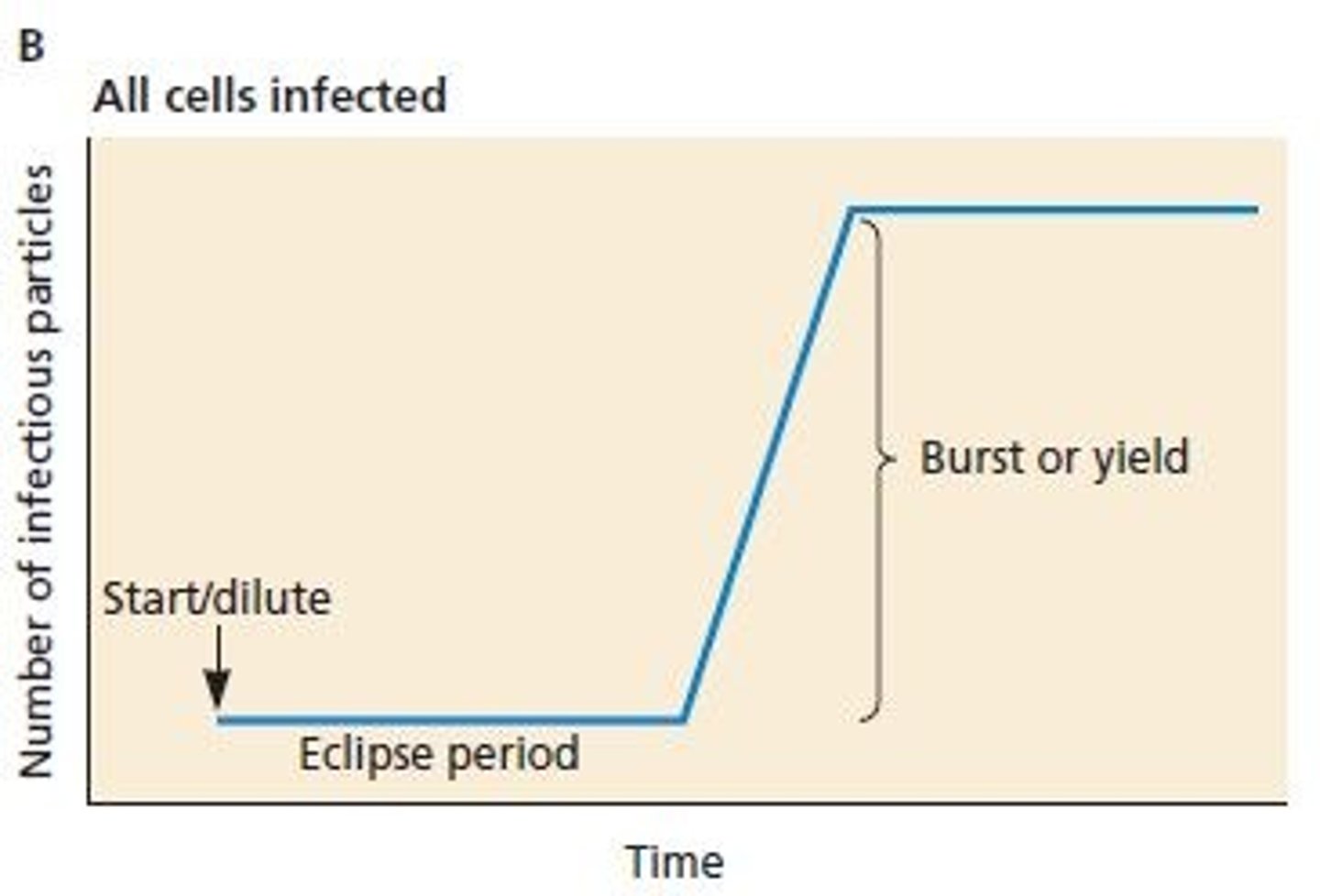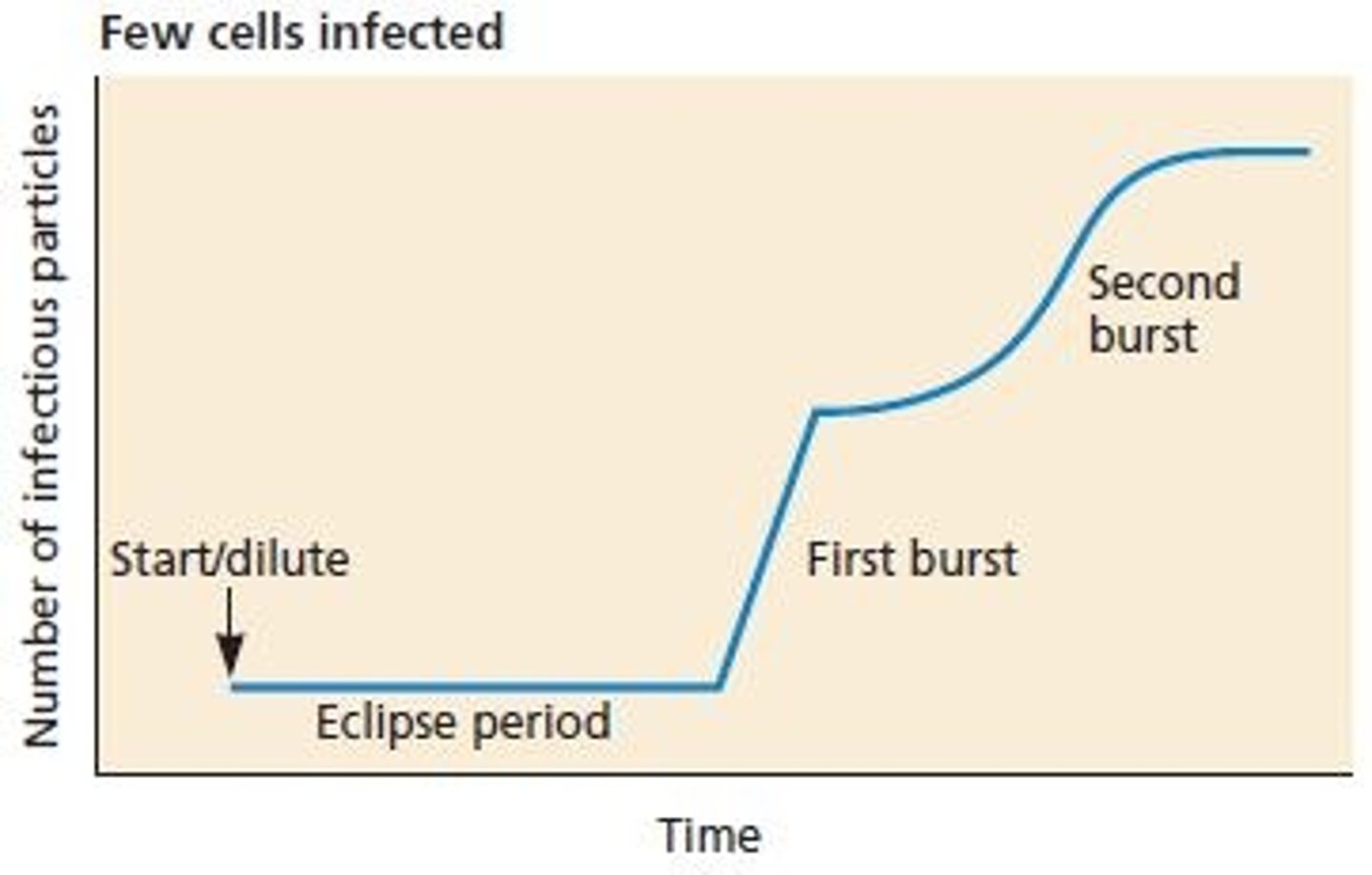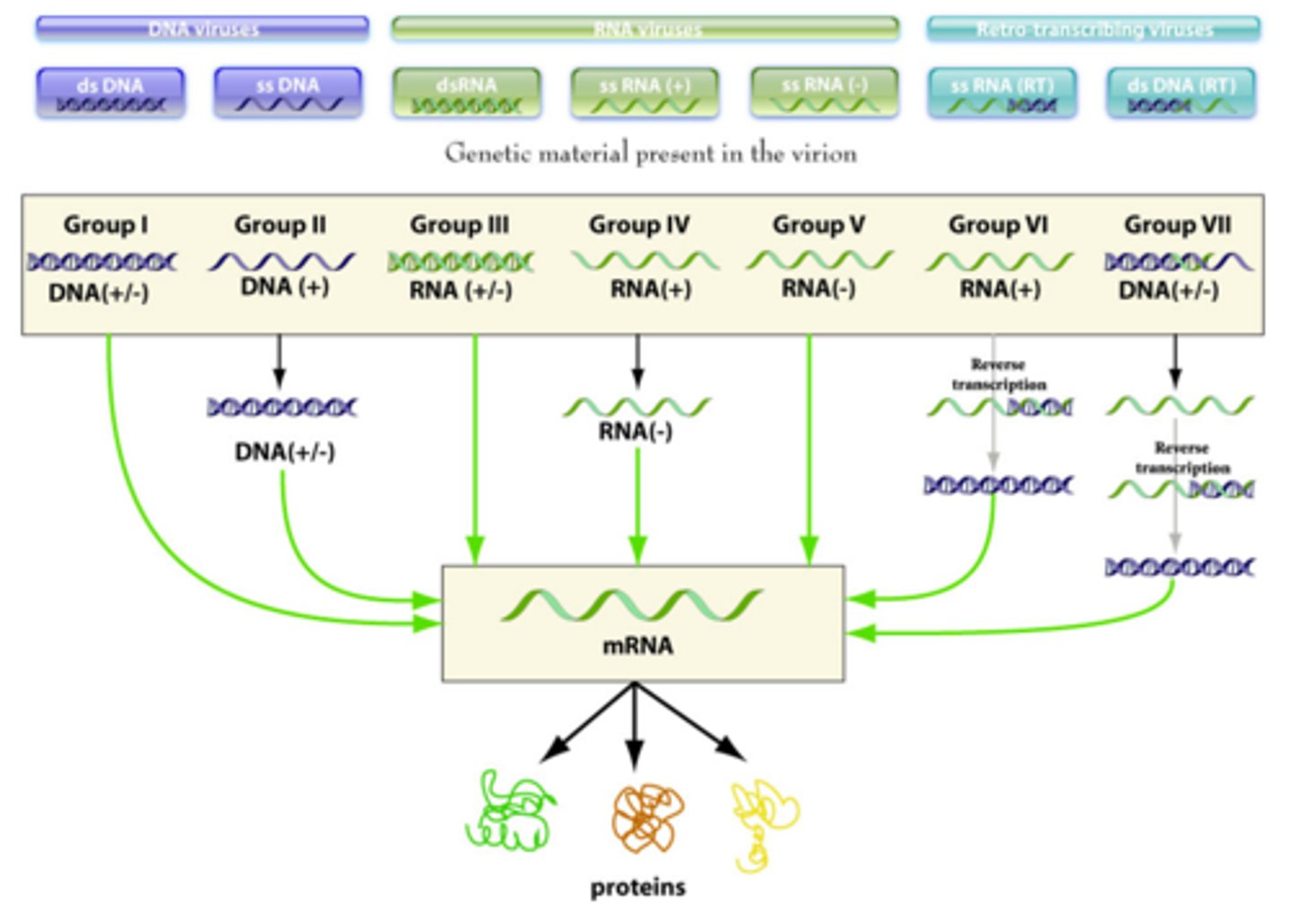MCB5505 Exam 1
1/305
There's no tags or description
Looks like no tags are added yet.
Name | Mastery | Learn | Test | Matching | Spaced |
|---|
No study sessions yet.
306 Terms
5 ways to classify viruses:
1) size
2) shape
3) envelope
4) nucleic acid
5) type of host
Viral size range
Varies widely, 20-600nm
Viral shapes
icosahedral, helical, complex/prolate
Who is responsible for modern vaccines?
Edward Jenner
How was the first vaccine developed?
Jenner used cow pox virus and would scratch people with it as it was less dangerous, but provided immunity for small pox
Virology timeline
1) Leeuwenhoek- invented microscope, viewed protists
2) Pasteur- bacteria came from environment
3) Koch- germ theory
4) Ivanovsky and Beijerinck- tobacco mosaic virus, no infection with filtered stuff, so had to be smaller
5) Leoffler and Frosch- foot and mouth disease
6) First human virus- yellow fever
7) First oncogenic virus- chicken leukemia
8) Bacteriophage discovered, micro to micro
9) Electron microscope- now can visualize
10) Influenza discovered- Spanish, killed 1/3 of pop
11) Hershey-Chase- proved DNA isinherited genetic material, tracking radio activity
Variolation
Method of inoculation first used to immunize individuals against smallpox with material taken from a patient or a recently variolated individual, in the hope that a mild, but protective, infection would result
Multiplicity of Infection (MOI)
Ratio of infectious agents to infection targets
Poisson Distribution
P(n)=((m^n)(e^-m))/(n!)
m= multiplicity of infection
n= # of agents that enter the infection target
P(n)= probability that a cell will get infected by n agents
Viral pathogenesis
Process by which a viral infection leads to disease
infection vs disease
-infection is simply when a microbe entered and reproduced in the body
-disease is the impact on host
subclinical
without showing signs of disease
Cellular Pathogenesis
Effect of the host response fighting infection
Three outcomes of viral infection
1) no apparent change- dormancy
2) cell death- virus or host induced
3) cell transformation- mutation of host cell by incorporation of viral genome
-recruits innate immune response and later adaptive immune response to site of infection
Types of viral transmission
1) horizontal- direct/indirect, touch, person to person
2) vertical- bodily fluid or breastmilk, pre or post birth, parent to offspring
3) zoonotic
Which viral transmission is most common?
horizontal
Single-step growth curve
Provides quantitation of "burst size"; all cells go through the phases of infection simultaneously; High MOI (5 to 10)

Multi-step growth curve
cellular infection is not synchronized; small # of cells infected and may get multiple bursts; Low MOI (0.1)

5 major steps of viral replication
1) attachment and entry
2) translation
3) genome replication
4) assembly
5) release
Susceptible
cell possesses the functional receptor for a virus
Resistant
a cell does NOT possess a functional viral receptor
Permissive
a cell can replicate the virus
What type of cell is required for the entire infectious cycle to occur?
susceptible and permissive
Receptors must be used for virus to enter cell. T/F
True. Virus can use either the same receptor for attachment and entry or a different receptor for each, but must use a receptor.
mRNA is always the (+) strand. T/F
True
The DNA strand that is of equivalent polarity to mRNA is which strand, (+) or (-)?
(+) sense strand
Which strand compliments the (+) strand?
(-) sense strand
mRNA can be translated by ribosomes without any alterations. T/F
True
All (+) RNA is mRNA. T/F
False
Group I
DNA (+/-); immediate using host transcription mechanisms
Group II
DNA (+); ss to ds, host mechanisms convert to mRNA
Group III
RNA (+/-); viral enzymes packaged w/ genetic material
Group IV
RNA (+); genome used as mRNA, also used to make RNA (-) strand, viral enzymes packaged w/ genetic material
Group V
RNA (-); viral enzymes packaged w/ genetic material
Group VI
RNA (+); retroviruses, RT to DNA then to mRNA
Group VII
DNA (+/-), segments of dsDNA, but also viral RNA woven into it; DNA to RNA to dsDNA then to mRNA
Baltimore Scheme
7 classes of taxonomy based on nucleic acids

5 types of viral genome structure
1) linear- most simple
2) segmented- influenza
3) ambisense- almost always RNA viruses
4) circular- like plasmids
5) gapped- unique to Hepadnaviridae; broken stranded with ds and ss portions
What is the name of the virus with the smallest genome and how many proteins does it encode for?
Circovirus, 1 protein
What types of proteins are NOT encoded in viral genomes?
-complete protein synthesis machinery
-energy production
-membrane synthesis
What types of proteins ARE encoded in viral genomes?
-replication of genome
-assembly/packaging of genome
-regulation of replication timing
-viral release and spread
-modulation of host defenses
Explain process of replication of (+/-) dsDNA genome
1) immediately converted to +mRNA by host RNA pol II
2) +RNA translated into proteins
-some for impacting cellular processes to help increase viral infection
-others involved in copying viral material like DNA pol
3) viral DNA pol copies dsDNA to get incorporated w/ particle or make more +mRNA
Gapped circular dsDNA does not have to be repaired before translation. T/F
False. Genome must be repaired first
How do gapped circular DNA viral genomes get repaired and converted to dsDNA?
using host cellular enzymes
Gapped circular dsDNA genome goes through transcription, translation and conversion of dsDNA to mRNA with cellular proteins. T/F
True
Explain process of gapped circular dsDNA replication
1) gaps repaired with cellular enzymes
2) repaired genome used to make mRNA with cellular mechanisms, which then go on to make proteins for assembly
3) mRNA made from cell is used to make RT in order to make +RNA then -DNA then +/- DNA, via cellular or viral DNApol, for packaging into to particle
ssDNA must become dsDNA before it can be replicated in the cell. T/F
True
Explain (+/-) ssDNA replication
1) (-/+)ssDNA converted to dsDNA by host proteins
2) (+/-)dsDNA used for mRNA then proteins for viral particle
3) proteins also used to make viral DNA pol to convert (+/-)dsDNA into ssDNA for incorporation into particle
Special enzyme encoded by RNA viruses
RNA-dependent RNA polymerase (RdRp)
Sometimes (+)RNA can be used as mRNA. T/F
True
Explain replication of dsRNA genome
1) RdRp from inside particle used to make mRNA
2) mRNA translated by host to make proteins for particle
3) host also makes more RdRp from mRNA that is used for copying of the genetic material that will be packaged into particle
Which viral genome replication is most efficient and why?
ss(+)RNA as it can be directly translated once in the cytoplasm
Explain replication of ss(+)RNA viruses
1) directly translated by host, some proteins used to form capsid
2) RdRp made and used to copy genome for packaging by making (-)RNA then (+)RNA
-(+)RNA can also be used to make more proteins if needed
Is RdRp encoded or packaged in ss(+)RNA viruses?
encoded, no need to package since it can be directly translated
Retroviruses form what before undergoing replication?
Provirus
What is a provirus?
the genetic material of a virus as incorporated into, and able to replicate with, the genome of a host cell.
What enzyme do retroviruses package?
Reverse Transcriptase
Why isn't retrovirus (+)ssRNA immediately translated?
the genetic material is protected by a sheath of proteins that prevent host cellular enzymes from getting in
Explain retrovirus replication
1) Reverse transcriptase used to make (-)ssDNA
2) cell enzymes used to make dsDNA from (-)ssDNA
3) dsDNA integrated into host chromosome-provirus
4) host cell makes viral mRNA for viral proteins which are used to replicate genetic material for packaging
5) replication of genome from dsDNA to form (+)ssRNA to package into particle
(-)ssRNA viruses must package own RdRp. T/F
True
Explain replication of (-)ssRNA genome
1) RdRp converts (-)ssRNA into mRNA
2) mRNA translated to make proteins for particle and more RdRp for copying genome
3) RdRp used to copy (-)ssRNA into (+)ssRNA and then into (-)ssRNA for packaging
Explain the lytic cycle
1) Virus attaches to the cell wall
2) Virus injects its DNA into the cell
3) Viral genome incorporated into bacterial genome
4) Viral proteins produce by host
5) Viral genomes and capsid parts assembled
6) Complete virus particle formed and lyses to escape killing host
explain the lysogenic cycle
Tied with lytic, after viral genome incorporated into host genome it sits silently. Bacterial host replicates and replicated the viral genome along with its own. Reactivation occurs and host creates viral particles that will be lytically released
What are the main ideas of the cellular origin hypothesis?
cells evolved first and viruses are derived from bits of nucleic acids that somehow "escaped", like plasmids
-explains specificity, as they come from the cells they infect
-explains the genetic similarity between most viruses and host cells
What are the main ideas of the coevolution hypothesis?
both cells and viruses evolved together
-viruses appeared early in history of life
-even as early as before the 3 domains diverged
What are the two hypotheses of viral evolution?
1) cellular origin- also called Progressive Hypoth.
2) coevolution
What is the other "cells first" hypothesis and what does it suggest?
Regressive Hypothesis- viruses were once free-living organisms that lost genetic information
-comes from similarities between mitochondria and bacterial cells
What is antigenic drift and what virus is an example of it?
random genetic mutation of an infectious agent resulting in minor changes in proteins called antigens, which stimulate the production of antibodies by the immune systems of humans and animals
-influenza's segmented ssRNA; seasonal flu
What is antigenic shift and what is an example?
a mechanism for variation in viruses that involves the accumulation of mutations within the genes that code for antibody-binding sites.
-human flu and avian flu both release/replicate their genomes. Genomes from both get packaged together into the same capsid
-leads to huge changes that can result in pandemic like Spanish flu
Which is more dramatic, antigenic shift or drift?
Antigenic shift
What purposes does the viral capsid serve?
-attachment to host cell (primary function)
-transporting the genome
-packaging of the nucleic acid
-protection of the nucleic acid
What viral proteins are designated as VP?
Structural proteins
What is another term for structural proteins?
Subunits
What are subunits made of?
polypeptide chains
What is the structural unit made of?
Subunits; can be 1 repeated or multiple subunit types
Capsid vs. Nucleocapsid
Capsid - protein coat around genome of non-enveloped viruses
Nucleocapsid - refers to capsid-genome unit substructure of enveloped viruses
Where does the viral membrane (envelope) come from?
host cell
What type of bond contacts do structural subunits have?
similar, non-covalent
Symmetrical order of viral proteins determines what?
capsid shape
What do the non-covalent bonds and non-identical interactions between subunits provide?
metastability of the viral particle
-have to be strong enough to protect the genome, but needs to be able to come apart to release the genome into host
Explain the helical capsid shape
identical subunits repeated and have helical symmetry
-binding with nucleic acid and forms regular pattern
All helical animal viruses are enveloped. T/F
True
Explain the icosahedral capsid shape
20 faces of equilateral triangles
All icosahedral capsids have precise numbers of proteins. What are they often in multiples of?
multiples of 60
What determines the size of an icosahedral capsid?
the change in # of proteins, not the change of proteins
How many axes of symmetry do icosahedral capsids have and what are they called?
3 axes of symmetry
1) Fivefold
2) Twofold
3) Threefold
What is the "catch all" category of capsid shapes?
Complex
How is an enveloped acquired?
by budding through the membrane of host cell
Where do capsids form prior to budding?
underneath the membrane
Envelopes can only be surface membranes. T/F
False. They can be either surface or internal membrane like the Golgi or ER
Envelopes are never lipid bilayers. T/F
False. They are always lipid bilayers
What capsid shape can nucleocapsids be inside an envelope?
icosahedral or helical
Only some envelopes have viral glycoproteins that protrude outward. T/F
False. All envelopes have viral glycoproteins
What are viral glycoproteins used for?
They are necessary for recognition of the host cell
Explain the two-step process of viral attachment
1) initial adherence- non-specific and guided by electrostatic forces
2) mediated by binding of host receptors- very specific, guided by non-covalent interactions and can involve one or more receptors
How is viral attachment guided by electrostatic forces?
as viruses do not have any means of locomotion, they float along until they bump into a potential host cell and move along the surface until they come across a receptor
Binding of virus to host receptor is non-specific. T/F
False. Binding is very specific
Initial adherence of virus to host cell is non-specific. T/F
True.
What dictates the receptors viruses use?
the shape of the virus and the shape of the receptor
Only one class of cell surface proteins can be a viral receptor. T/F
False. Almost every class of surface protein can be used